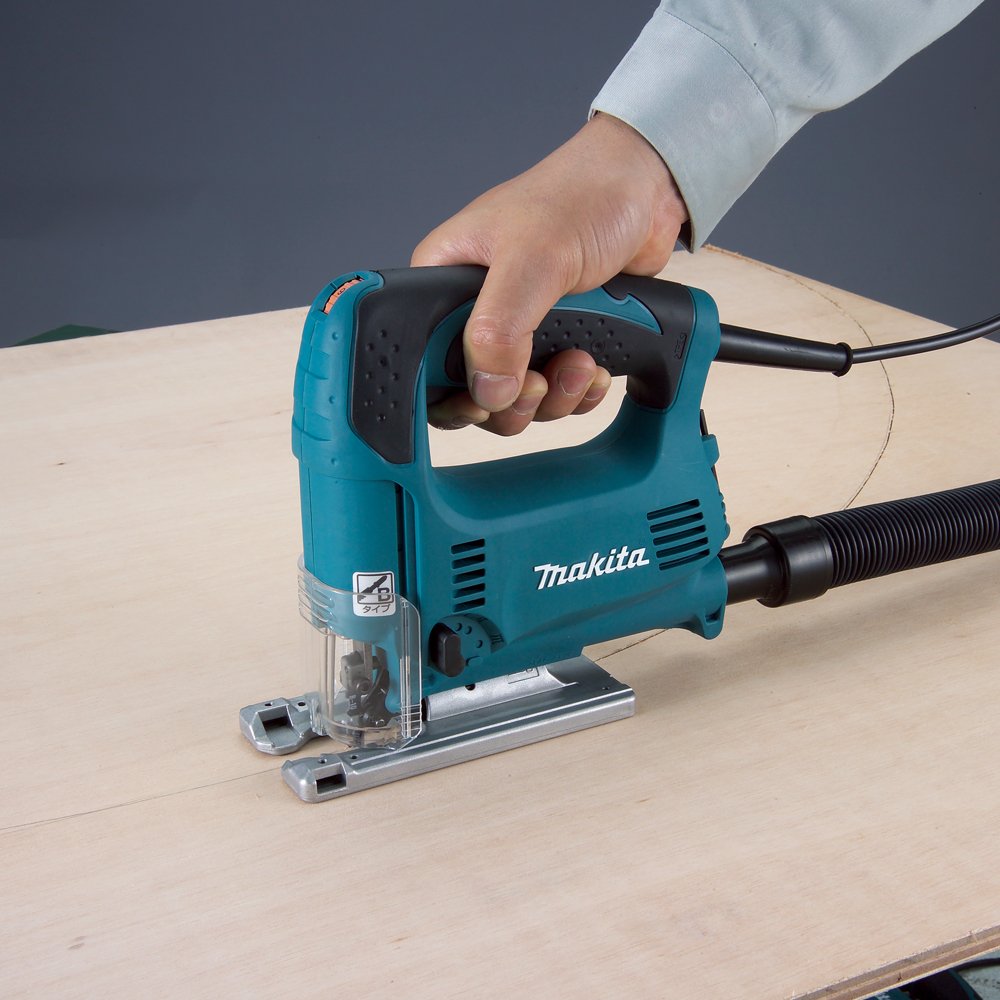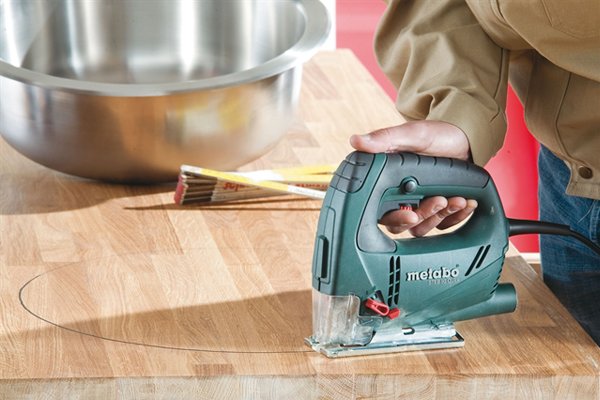
A Jigsaw is a handy power tool with an electric motor and reciprocating saw blade. If you’re contemplating buying one this thought may come to mind; ‘what to use a jigsaw for?’ In other words, what can I do with it and what will I use it for? What projects could I do with this tool and will I be able to use it for other projects too? You may want to check out our guide on Wood Projects That Sell.
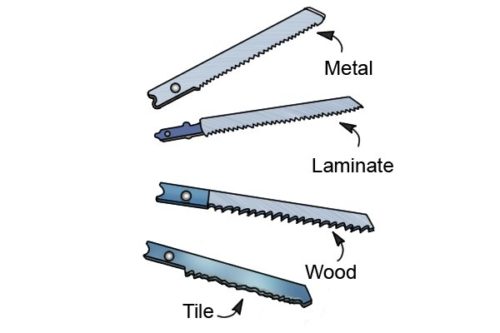
A jigsaw can be used on a wide variety of materials (wood, metal, plastic, etc) for all sorts of purposes (curved cuts, straight cuts, bevel cuts etc). They are primarily used for making curved, intricate cuts in wood and patterns (hence the name jigsaw – like the puzzle).
Although jigsaws are most commonly used in woodworking, the machines are really quite versatile. All you need to do is change out the blade and you can cut through a variety of materials. To see our guide on the best jigsaw under $100, click here.
Need to learn how to use a jigsaw? Check out our guide, How To Use A Jigsaw.
What Materials Can A Jigsaw Cut?
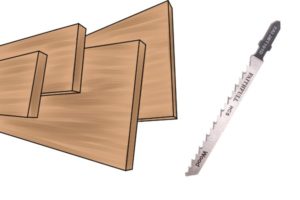
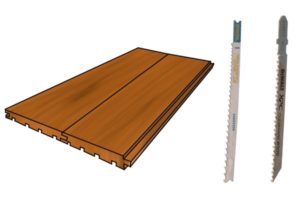
Wood: jigsaws can cut different types of wood from plywood to construction timbers like oak or pine. It can also cut through wood with embedded nails.A jigsaw is ideal for all sorts of scrollwork, for cutting stencils, and adding decorative patterns to make an amazing piece of furniture.
With projects like this (especially if the timber is expensive) you need to know what you’re doing so you don’t ruin the wood.
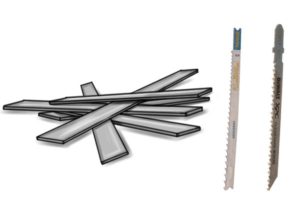
the blade should have small, closely-spaced teeth, with a TPI of at least 14.
Metal: can be used in sheet metals such as steel, aluminium or iron or even non-ferrous piping. You can make broad curves or straight lines with powerful motors able to cut through thicker metal.
Using a jigsaw on metal comes in handy when you need to cut a hole through which a pipe can fit. Likewise there will also be times you’ll need to cut curves in metal for it to fit on a wall.
Although a jigsaw can be used on pipework you really shouldn’t use it to cut straight lines with metal. The tool is not really designed for this and won’t accomplish the task very well at all.
Carpet: Why you might not normally think of cutting carpet with a power tool, if you want a bit more accuracy than what you’ll get with a utility knife or scissors, consider a jigsaw.
It actually cuts carpet remarkably well.
You’ll need to get a ‘special soft material blade’ (yep this is it’s proper name) so you can get a clean cut. Other soft materials you can cut with include; leather, polystyrene and cardboard.
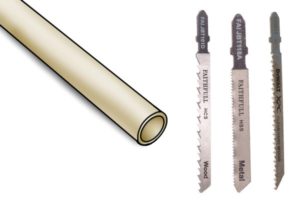
Plastic (including fibreglass): It is best to use a jigsaw at slow speed to effectively cut through plastic including Perspex and fibreglass.
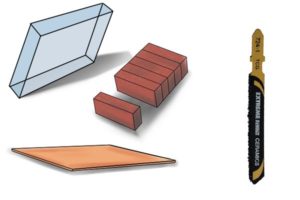
Ceramic Tile: Using a narrow ceramic tile blade allows you to make more intricate cuts in tiles than the alternative tile-cutting tool (a tile cutter) which can only make straight cuts.
It is particularly handy if you need to cut a semicircle or curve around a pipe.With the correct blade on your jigsaw, you can easily accomplish cutting through ceramic tile.
Admittedly it easier with a tile cutter, but if you don’t have one, you can use a jigsaw. We would recommend one with a carbide grit jigsaw blade.
Plasterboard: If you need to make a cut out in plasterboard (like for electrical outlets), a jigsaw can be used as a powered alternative over the drywall saw.
Concrete: To cut into concrete (and really we’re talking about small jobs) you’ll need to get a blade that is suitable for porous concrete and fibre cement.
Admittedly it’s not recommended to use on all concrete and cement jobs, but the right tool and blade combination could be used to create a hole or opening for a pipe.
Laminate: Jigsaws are often used when installing a new laminate kitchen worktop. Cut outs are often required to allow the installation for things like sinks and appliances. Jigsaws can effectively cut through hard and thick materials like laminate.
What To Use a Jigsaw For (All Sorts of Cuts!)
-
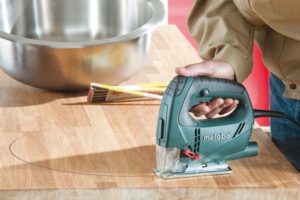
Using a jigsaw to make a curved cut Curved cuts: Jigsaws are not circular saws or miter saws and their thin blades are designed for more delicate and intricate cuts. The upside though is the blades can easily fit into tight spaces and follow a curved line with ease. Plus they are not very heavy so they’re easy to pick up and guide along stencilled designs. This makes them perfect for cutting circles of almost any size – either freehand or with the aid of a circle cutting guide.
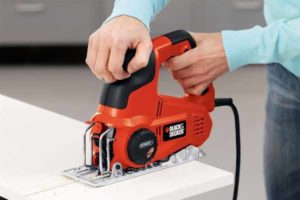
Straight cuts: For a straight cut you’ll need a slightly wider blade with the tool guided along a straight edge to make straight cuts.
You can make straight cuts either along or across the grain of wood in even in other materials such as laminate. Just be mindful that the narrow blades can be prone to bending and can move off course. So if you want a neat, straight cut with a jigsaw, you’ll need to be careful.
Plunge cuts: A plunge cut allows you to start in the middle of your material rather than from the edge. Jigsaws are fairly unique as they allow you to do this. I
t comes in particularly handy for making holes in wood or plasterboard for electrical outlets or letter boxes. A common application of this type of cut is when making a sink cut-out in a new kitchen countertop. In this respect, you don’t have to rely on your drill to make a centre cut – your jigsaw can do this!
-

Using a jigsaw for a bevel cut Bevel cuts: If your jigsaw has a pivoting shoe, you will be able to make bevel cuts in mouldings and boards. The shoe typically can be positioned at angles up to 45 degrees so that the jigsaw cuts on a bevel.
- Countertop cuts: If you’re installing a new countertop in your kitchen or bathroom, you will need to make cuts to accommodate faucets and sprayer hoses. As they often require small, round holes, jigsaws are ideal for this purpose (unless it’s already pre-cut of course).
- You’ll need to get blades specifically designed to cut countertops in order to do the job correctly. We recommend getting a downstroke jigsaw blade as these are purposefully designed for hard, deep surfaces such as countertops.
-
Rough cuts: jigsaws are able to do fast rough cuts when the overall finish is not so important. We recommend you choose a coarser blade with a lower TPI. As these blades have less teeth, they are able to remove more material each time they move up and down cutting through a workpiece fairly quickly.
Do You Need a Jigsaw for Your Project?
 At the end of the day a jigsaw is primarily used for cutting curves and stencilled designs. There are other tools of course that will do this too so you won’t always have to rely on a jigsaw for cutting circles and curves.
At the end of the day a jigsaw is primarily used for cutting curves and stencilled designs. There are other tools of course that will do this too so you won’t always have to rely on a jigsaw for cutting circles and curves.
Tools such as coping saws, reciprocating saws, fret saws, rotary saws, scroll saws and band saws will do similar tasks and are well worth looking into too. Click here for our guide on Wood Cutting Machines For Home Use. Since there are so many other electric saws on the market, by choosing the right one, you can make your project a whole lot easier.
Although jigsaws are primarily used for woodworking, it is handy to know there other other materials you can use them with too – especially if your power tool budget is already at capacity!
When you look at all the different projects you can make with a jigsaw (and there are a lot of them), there’s no doubt they’re particularly useful for cutting curves, stencils and irregular shapes from wood.
The various applications and uses for a jigsaw is due to the different blades available which can all cope with all sorts of materials. So if you’re in the market for a jigsaw, ensure you check out the types of blades on offer. It is good to know though that replacement blades are easy to source and are relatively inexpensive.
We have compiled two reviews guides listing our recommended jigsaws for a wide variety of jobs – what is the best jigsaw on the market? This article considers what is popular right now (the best sellers) and details our pros and cons of our top 5 choices.
We also have done a budget guide on Best Jigsaw Under $100 as jigsaws do not need to be expensive at all to be useful on a range of different applications.
